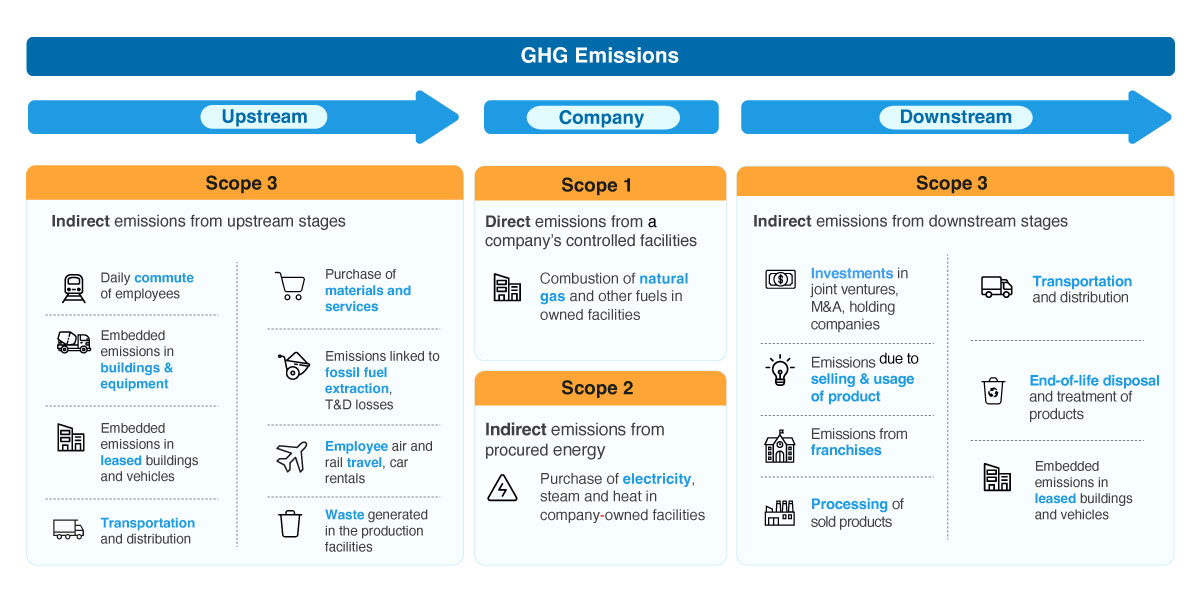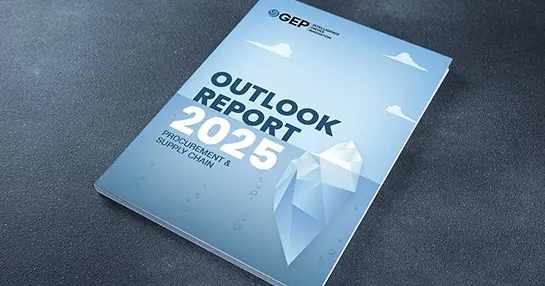The urgency to reduce greenhouse gas emissions means every business must act. One way to make a crucial difference is by reducing Scope 3 emissions.
Companies often know how to tackle Scope 1 and 2 emissions, generated through their operations or through energy use. But Scope 3 emissions are more complex, spanning the value chain, from suppliers to distributors and customers. They can exceed 80% of a company’s total emissions. While reducing Scope 3 poses thorny challenges, it also offers the biggest sustainability gains.
Advantages of GEP’s Data-Driven Approach
- Connect data sources and leverage actionable intelligence.
- Capture metrics, establish and execute emission reduction goals.
- Determine baseline to set targets and measure performance.
- Combine software and services for agility and cost efficiency.
- Build a framework of proven processes for rapid ROI and adaptability.

Upstream and Downstream Emissions a Corporation Can Influence
How GEP Can Help Reduce Scope 3 Emissions
GEP begins by evaluating procurement and supply chains to establish your Scope 3 emissions baseline and segment your suppliers. Tackling Scope 3 offers a great opportunity to engage with suppliers, build relationships, boost efficiency and drive innovation.
Reporting & Insights
Measuring Scope 3 carbon emissions is among the major challenges to building a sustainable value chain. Any effective Scope 3 solution must be grounded in rigorous measurement and tracking of upstream and downstream emissions. That’s why GEP SMART™, our AI-powered, cloud-native software, includes an emissions-tracking dashboard.
Leverage GEP’s innovative technology to secure continuous visibility and monitor Scope 3 performance. Our custom-created emissions dashboard is built to accommodate your needs and develop data-driven strategies to reduce your carbon footprint.
Strategy
At GEP, we help you set GHG reduction goals and translate this into a road map and strategy. Procurement contributes to achieving emissions goals by selecting the best suppliers with the right sustainability metrics. We identify the challenges your procurement team faces in meeting sustainability objectives and collaborate to deliver a practical approach to tackling sustainability in your supply chain. Additionally, we help our clients build a governance framework for annual disclosures/reporting.
Transform
Reducing Scope 3 emissions requires changing how you do business and category management. At GEP, we embed sustainability into sourcing by proactively engaging and collaborating with suppliers to drive sustainability efforts. We help target key suppliers, develop collaboration strategies and identify ESG-leading suppliers, prioritizing sustainability performance in our selection criteria.
Our Track Record
- Through in-depth spend analysis, category-specific approaches and extensive market research, GEP created a sophisticated data model for a client to calculate its Scope 3 emissions baseline. We also designed an emissions dashboard to enable data-driven strategies for reducing Scope 3 emissions.
- Supported a global Fortune 500 CPG company in setting climate goals and sourcing strategy. Developed a climate target backed by a comprehensive decarbonization road map and designed a dashboard for access to all projects and financials by location.
- Partnered with a Fortune 500 manufacturing and chemicals company to optimize its warehousing supply chain network in Europe, achieving a 19% reduction in carbon footprint and an 18% reduction in costs.
- Developed a fleet electrification strategy for a $14B U.S. agriscience company with a three-step pilot approach and a comprehensive guide for electric vehicle adoption.
GEP Offerings for ESG Excellence
FAQ
There’s a mounting pressure on organizations to address their entire carbon footprint, with Scope 3 emissions typically accounting for over 70% of enterprise carbon impact. The urgency for implementing a comprehensive Scope 3 strategy has intensified due to converging regulatory, market, and stakeholder forces that make further delay increasingly risky.
Regulatory frameworks are rapidly evolving. The EU Corporate Sustainability Reporting Directive, SEC climate disclosure rules, and similar global regulations mandate comprehensive emissions reporting. These requirements specifically target Scope 3 emissions, imposing potential compliance challenges for unprepared organizations. Early implementation provides crucial adaptation time before enforcement deadlines.
Investor scrutiny too has intensified, with major institutional investors and asset managers now integrating Scope 3 performance into investment decisions. Companies lacking robust Scope 3 strategies are at risk of facing capital access constraints, higher financing costs, and decreased valuation multiples.
Customer and supply chain pressures are equally significant. Large enterprises increasingly extend decarbonization requirements to their suppliers, making Scope 3 capabilities essential for maintaining commercial relationships. Organizations lacking comprehensive emissions data risk exclusion from important procurement opportunities and partner ecosystems.
The technical complexity of Scope 3 measurement and management necessitates longer implementation timelines. Establishing reduction initiatives requires significant lead time, and organizations that delay implementation have to deal with rapid timelines and rushed solutions.
First-mover advantages exist for organizations that proactively address Scope 3 emissions. Early adopters can secure limited carbon reduction opportunities within their value chains, develop innovative low-carbon products, and establish market leadership positions.
Given the aforementioned converging pressures, organizations must develop comprehensive Scope 3 strategies now to ensure compliance readiness, maintain stakeholder confidence, and create sustainable competitive advantage in an increasingly carbon-constrained business environment.
Scope 3 emissions represent the indirect greenhouse gas emissions that occur throughout an organization's value chain, extending far beyond operational boundaries to encompass both upstream and downstream activities.
Upstream in the value chain, Scope 3 emissions originate from purchased goods and services, where embedded carbon from raw material extraction, manufacturing processes, and supplier operations, contributes significantly to overall impact. Capital goods acquisition introduces emissions through the production of equipment, machinery, and infrastructure that organizations use. Employee commuting and business travel generate emissions through various transportation modes, while fuel and energy-related activities not included in Scope 1 or 2 cover emissions associated with fuel extraction, production, and transportation.
The complex middle of the value chain includes transportation and distribution between an organization's operations and its suppliers or customers. Waste generated in operations creates emissions through disposal and treatment processes, while leased assets and franchises contribute emissions that may not appear in traditional operational boundaries.
Downstream elements encompass the use of sold products, where emissions occur during customer utilization and maintenance. Product end-of-life treatment introduces emissions through disposal, recycling, or waste management processes. Investments represent another significant category, particularly for financial institutions, covering emissions associated with equity investments, debt holdings, and project finance activities.
Effectively managing Scope 3 emissions calls for a comprehensive approach that begins with robust measurement practices — including supplier data collection, spend-based calculations and life cycle assessments. Organizations must develop supplier engagement strategies that combine education, capability building and performance requirements. Product design modifications can address use-phase and end-of-life emissions, while innovative business models may fundamentally alter emission profiles across the entire value chain.
By understanding and addressing these diverse Scope 3 emission sources, organizations can develop targeted reduction strategies that deliver meaningful climate impact while enhancing supply chain resilience and stakeholder relationships.
Organizations can systematically address their most challenging emissions through a comprehensive 5-stage approach targeting value chain decarbonization.
Stage 1: Comprehensive Measurement and Hotspot Analysis
Establishing accurate baseline measurements across the Scope 3 categories defined by the GHG Protocol requires hybrid measurement approaches. By combining spend-based calculations, supplier-specific data, and life cycle assessments, organizations can identify emission hotspots and prioritize high-impact intervention areas. Advanced analytics enable granular visualization of emission sources by geography, business unit, and supplier tier.
Stage 2: Strategic Target Setting and Governance
Develop science-based targets aligned with 1.5-degree C pathways, incorporating both absolute reduction goals and intensity metrics tied to business growth. Implement robust governance mechanisms with clear accountability, typically involving a cross-functional steering committee. Integrate Scope 3 metrics into executive compensation and establish internal carbon pricing to drive strategic decision-making.
Stage 3: Supplier Engagement and Capability Building
Design tiered engagement strategies tailored to supplier significance and maturity. This includes:
- Education programs and technical assistance
- Collaborative innovation initiatives
- Capability-building workshops
- Emissions calculation tools
- Financial incentives linked to carbon performance
- Evolving procurement criteria to incorporate emissions considerations
Stage 4: Product Design and Business Model Innovation
Rethink products and services through collaborative design approaches using life cycle assessment methodologies. Key strategies include:
- Material substitution
- Lightweighting
- Energy efficiency improvements
- Designing for circularity
- Customer engagement programs
- Exploring transformative business models like product-as-a-service
Stage 5: Transparency and Continuous Improvement
Focus on transparent reporting through frameworks like Carbon Disclosure Project (CDP) and Task Force on Climate-related Financial Disclosures (TCFD) while establishing continuous improvement mechanisms. Implement feedback loops to:
- Refine measurement approaches
- Update reduction strategies
- Capture emerging opportunities
- Engage in industry collaborations
- Leverage digital traceability solutions
By systematically implementing the above-mentioned plan, organizations can achieve meaningful Scope 3 emissions reductions while building climate resilience throughout their value chain.
Absolutely. For any serious net zero commitment, Scope 3 emissions have to be addressed, which typically represent over 70% of most organizations' carbon footprints. Most companies typically handle Scope 1 and 2 emissions from their direct operations, but Scope 3 is a bigger challenge.
Scope 3 emissions span the entire value chain, starting from suppliers to distributors and customers. As a result, ignoring them would mean missing the biggest opportunity for climate impact.
GEP works with organizations to develop science-based targets that align with 1.5-degree pathways. The approach combines both absolute reduction goals and intensity metrics tied to business growth. The reality is stark. Excluding Scope 3 could actually make your net zero commitments meaningless.
Enterprises serious about climate leadership must develop comprehensive strategies that cover upstream suppliers as well as downstream customers. GEP's methodology establishes accurate baselines and implements reduction strategies across all emission categories, ensuring genuine progress toward net zero goals.
Scope 3 emissions are important in ESG reporting as regulations continue to tighten globally. The EU Corporate Sustainability Reporting Directive and SEC climate disclosure rules now specifically target these emissions, mounting pressure organizations that aren't prepared.
This shift also reflects investor demands. Big institutional investors integrate Scope 3 performance into investment decisions, affecting capital access and company valuations. Organizations that continue without robust emissions data will face exclusion from procurement opportunities and partner ecosystems.
GEP assists companies in building governance frameworks for annual disclosures that meet these requirements. Our expertise translates complex Scope 3 data into transparent reporting through established frameworks.
Establishing enterprise-wide comprehensive emissions management takes time. And organizations that tend to delay implementation are more likely to face rushed solutions and compliance issues. GEP's approach is systematic, ensuring companies can maintain stakeholder confidence while meeting regulatory demands across geographies.
Supplier engagement for Scope 3 reduction faces several practical hurdles. The biggest challenge is measurement complexity; tracking emissions across diverse supplier ecosystems requires sophisticated systems that many suppliers lack.
Data collection can become fraught with issues when suppliers don't have emissions tracking capabilities. Each tier of suppliers requires different engagement approaches, from basic education for smaller vendors to advanced collaboration with strategic partners.
Furthermore, most suppliers view carbon reporting as an additional burden rather than business opportunity. A such, this mindset acts as a deterrent and therefore requires careful change management and clear value propositions. The focus should be on making suppliers view carbon reduction as a competitive advantage.
GEP tackles the aforementioned challenges through tiered engagement strategies that match supplier significance and maturity levels. The approach includes collaborative innovation initiatives and emissions calculation tools, transforming suppliers from passive compliance targets into active decarbonization partners.
Most businesses don't always have the in-house knowledge to deal with Scope 3 emissions properly. And it's important to avoid costly mistakes and rushed solutions. Professional help goes a long way because the technology is complicated along with varied implementation times.
Managing emissions in the value chain requires a comprehensive knowledge of procurement, sustainability, and staying compliant with the rules. It takes years to build expertise within a company.
GEP uses tried-and-true methods that have worked across industries and geographies. We look at procurement and supply chains to set accurate baselines and group suppliers in a way that makes sense, ensuring you get a measurable return on your investment.
Professional consultants know how to deal with changing rules in different places and how to meet the needs of many different stakeholders. You get access to new technologies and well-known supplier networks that would be expensive to build on your own.
By collaborating with experts, companies can get first-mover advantage while still focusing on their main business activities. The result is that emissions are reduced more quickly and more effectively.




















